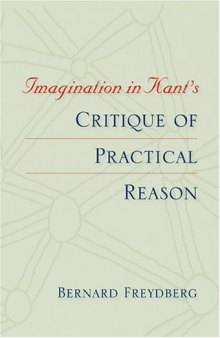دانلود کتاب Imagination in Kant's <I>Critique of Practical Reason</I> (Studies in Continental Thought)
by Bernard Freydberg|
|
عنوان فارسی: تخیل در کانت به u0026 lt؛ من u0026 gt؛ به نقد عقل عملی به u0026 lt؛ / I u0026 gt؛ به (مطالعات انجام شده در قاره اندیشه) |
 دانلود کتاب
دانلود کتاب
 جزییات کتاب
جزییات کتاب
Freydberg's approach is masterful for two reasons. First, instead of planting himself only within a textual analysis of the second critique, he bridges the first critique with the second. That is, he shows how the first critique informs and "opens up" into the second critique by appropriating the relevant passages and concepts from the "Critique of Pure Reason," most notably the role of synthesis/image-making and the imagination that powers it. This allows for an analysis that doesn't arise in a vacuum. Freydberg also examines the relation of the second critique to its successor, the "Critique of Judgment" much the same way as he does with the first. Second, in the bridging of the first critique to the second, Freydberg foregoes what could have been a more trouble-free appraisal. Instead of utilizing the A Deduction alone where imagination is prominent, he relies heavily on the B Deduction where Kant seems to have given imagination a "lesser" role. Thus he treads the more difficult path to make his case while also reaping the rewards that this type of journey brings at its conclusion.
Although Freydberg takes his cue from Heidegger (and in turn Sallis), his insights are original. Heidegger, in his book "Kant and the Problem of Metaphysics," claimed that the imagination is the root of both sensibility and understanding but that "Kant recoiled in the face of this unknown root." What makes this account both provocative and exciting is Freydberg's treatment of this "unknown root." He demonstrates that imagination, even when it seems to be absent, is in fact always, already deeply at work even in the construction of our moral framework.
For example, Kant says of the Triebfeder (incentives of pure practical reason) that they are the subjective ground of the determination of a will. As finite beings, we are subject to our pathological incentives. Yet through moral feeling that human beings are also subject, we are aware of the moral law as well (an a priori concept), which is the only law that qualifies as a moral incentive. Bridging this chasm is the imagination. Freydberg reveals how any determination of the will of a finite human being has already undergone the synthesis of imagination. In this case, imagination has generated an incentive out of the pure, moral law as well as bringing it (this moral incentive) into opposed play with our sensuous inclinations.
There are many more examples throughout this work that exemplify imaginations disclosing and synthesizing role. Freydberg's arguments are precise and well thought out. Although working within the continental tradition, he provides a close reading of the text, supporting his position with a logical rigor that should garner the respect of those in the analytic tradition.
In the last analysis, Freydberg's inquiry achieves the notable goal of disclosing how the imagination beats at the heart of the second critique in particular, and all three critiques in general. Suffice it to say that "Imagination in Kant's `Critique of Practical Reason'" is a work that adds sorely needed scholarship to the Kantian corpus. Ignored for too long by many Kant scholars, Freydberg discloses that which, although hidden, plays the crucial role in the "Critique of Practical Reason." Imagination at the heart of Kant's second critique...who would have thought?






 این کتاب رو مطالعه کردید؟ نظر شما چیست؟
این کتاب رو مطالعه کردید؟ نظر شما چیست؟
